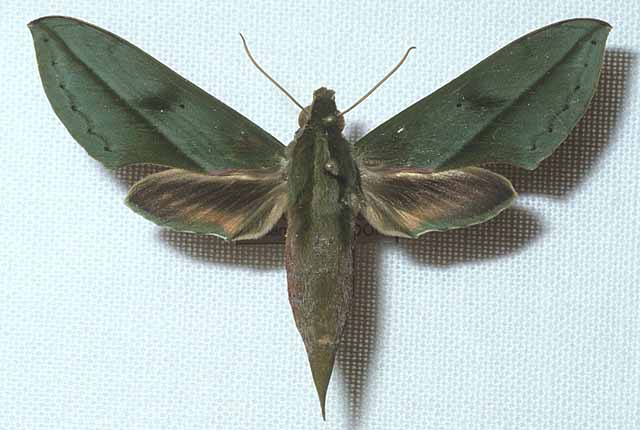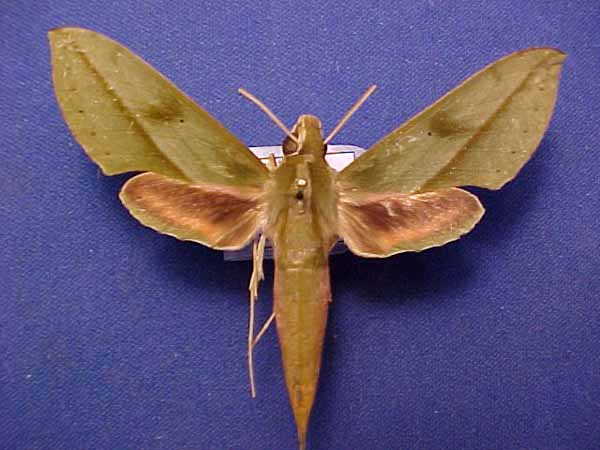Xylophanes rothschildi
Xylophanes rothschildi
zail-AH-fan-eesmmROTHS-child-eye
(Dognin, 1895) Theretra

Xylophanes rothschildi female courtesy of
Hubert Mayer
copyright.
This site has been created by
Bill Oehlke at oehlkew@islandtelecom.com
Comments, suggestions and/or additional information are welcomed by Bill.
TAXONOMY:
Family: Sphingidae, Latreille, 1802
Subfamily: Macroglossinae, Harris, 1839
Tribe: Macroglossini, Harris, 1839
Genus: Xylophanes Hubner [1819] ...........
Species: rothschildi Dognin, 1895
|
MIDI MUSIC
.....It's a Wonderful World.....
copyright C. Odenkirk
ON.OFF
<bgsound src="world.mid" LOOP=FOREVER>
|
DISTRIBUTION:
Xylophanes rothschildi moths fly in
Colombia (CATE),
Ecuador (specimen type locality) and
Peru and south to
Bolivia:
La Paz: Murillo, Río Zongo, (750m).
"Forewing upperside dark green with a bluish tint; base of wing deeper olive-green; a small oval patch of the same colour running longitudinally from the small,
round, black discal spot to the dark green oblique postmedian line, which runs from the middle of the inner margin to the apex; basal to this line are two
inconspicuous, narrow lines that recurve basad towards the costa; submarginal line represented by a row of small, black vein spots; fringe of inner margin from base to
postmedian line clearly pink.
Hindwing upperside generally blackish with a diffuse and poorly defined pinkish-orange median band.
MaleWingspan 6.28 - 7.15 cm, average = 6.74 cm." CATE

Xylophanes rothschildi courtesy of John Vriesi.
FLIGHT TIMES:
Xylophanes rothschildi adults fly????
ECLOSION:
Pupae probably wiggle to surface from subterranean chambers just prior to eclosion.
SCENTING AND MATING:Females call in the males with a pheromone released from a gland at the tip of the
abdomen. Males come in to lights very readily, but females are seldom taken in that way.
EGGS, LARVAE, PUPAE:
Larvae probably feed on
members of the Rubiaceae or Malvaceae families.
Moths emerge approximately one-two months after larvae pupate.
Use your browser "Back" button to return to the previous page.
Goto Main Sphingidae Index
Goto Macroglossini Tribe
Goto Central American Indices
Goto Carribean Islands
Goto South American Indices
Goto U.S.A. tables
The pronunciation of scientific names is
troublesome for many. The "suggestion" at the top of the page is
merely a suggestion. It is based on commonly
accepted English pronunciation of Greek names and/or some
fairly well accepted "rules" for latinized scientific names.
The suggested pronunciations, on this page and on other pages,
are primarily put forward to assist those who hear with internal
ears as they read.
There are many collectors from different countries whose
intonations and accents would be different.
Jean Marie Cadiou writes, "When I say "Xylophanes" in English I
pronounce it something like "Zailophanees", with the emphasis on the
"o". The French pronounce it differently, something like
"Kzeelophaness" with no emphasis, and the Germans yet in a
different way..."
Some of the early describers/namers chose genus
and species names indicating some character of the insect, but more
often, they simply chose names from Greek or Roman mythology or
history.Those species names which end in "ensis" indicate a
specimen locale, and those which end in "i", pronounced "eye", honour
a contempory friend/collector/etc.
"Xylophanes" sounds like it is from Greek mythology,
and rothschildi is probably an honorific choice for
William Rothschild, a contemporary.

